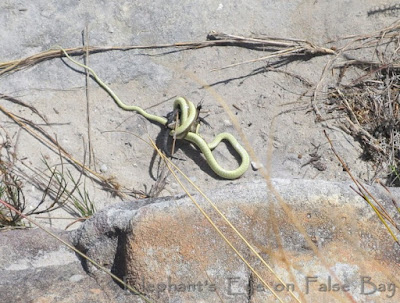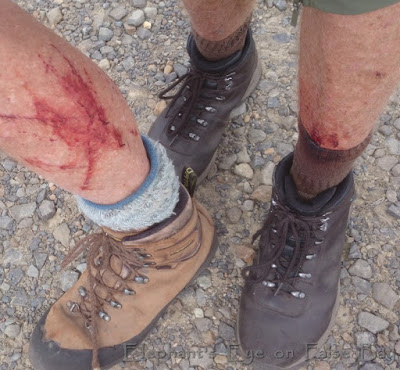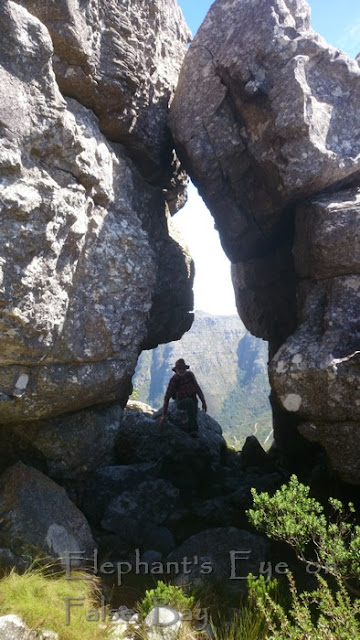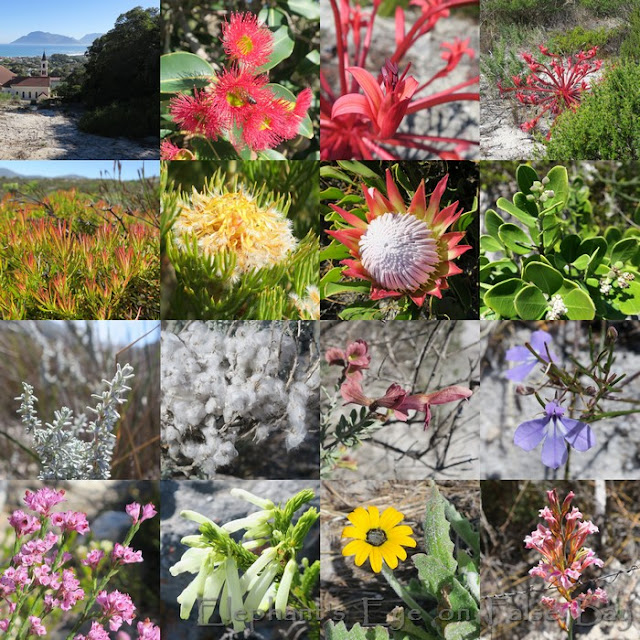Hiking battles and our Neighbourhood Farm
by Diana Studer
- gardening for biodiversity
in Cape Town, South Africa
Hiking among
wildflowers
and in the mountains
around Cape Town
In March his group hiked up to Blokhuiskop (seen from our
bay window) from where he could look down to our beach.
We hiked along Steenberg at Silvermine. Coming down the
'steps' we found a life and death battle. Too late for the Black Girdled
Lizard's tail-biting defence. A successful hunt for the Karoo Sand Snake. We
took our photos and circuited carefully alongside the path.
Cordylus niger Black Girdled Lizard.
Psammophis notostictus Karoo Sand
Snake.
Lobelia coronopifolia
deep blue with white flashes. Gladiolus
brevifolius is hooded, its lower tepals with various delicate markings.
Roella ciliata
banded in blues.
Distant stream of cars on Ou Kaapse Weg. Saltera sarcocolla in electrifying pink.
Gnidia juniperifolia (4 x 2 petals
and calyx).
He had a turn at trail blazing, stabbed by burnt ends of
branches. Eina!
Hoof print of a small antelope. We walked slowly down to Smitswinkel
Bay. Polygala myrtifolia with tassels
and purple veins. Psoralea pinnata
fountain bush grows with wet feet.
Leucospermum conocarpodendron with leaf
nectaries. Kiggelaria africana
fruit. Coral fern Gleichenia polypodiodes.
Serious thorns on Gymnosporia buxifolia.
Erica ericoides
with dark dangly bits. Tiny furry Erica
parviflora. Spotted blister beetle on Osteospermum
monilifera. Hibiscus aethiopicus
low on the ground.
Phylica ericoides.
Struthiola ciliata with an eight
spiked central crown. Kniphofia uvaria.
Wine dark sea edges to Cotyledon
orbiculata leaves.
He was on Klaasenskop and along Cecilia Ridge.
We walked along a sadly dry Silvermine River. Erica multumbellifera little cherries. Erica abietina. Erica ericoides dark dangly bits. Berzelia lanuginosa.
Camphorbush Tarchonanthus
littoralis (the female I wanted in the garden with fluff for bird's nests).
Cunonia capensis (rooiels) flower and its butterspoon.
Fresh dark Cape myrtle leaves Myrsine
africana.
Tall ivory umbels Hermas
villosa with large and decorative leaves. Yellow crab spider lurks on Helichrysum cymosum. Stoebe cinerea flower and the bush so
striking once backlit by sunshine.
Tall Bulbine praemorsa.
Vivid Indigofera filifolia. Muted Indigofera cytisoides spikes. Sky blue Pseudoselago serrata.
We walk up to Slangkop from the Catholic church past a Eucalyptus avenue (water guzzling
invasive aliens, but the beekeepers like them). Here we saw Brunsvigia orientalis (which had
been disappointingly mown down or dug up from the firebreak at Smitswinkel)
Glowing red Leucadendron
salignum leaves. Golden Serruria
villosa. Extravagant Protea
cynaroides. Olea capensis
ironwood with tiny fruit.
Silver leaves and fluff -
kapokbossie - wild rosemary Eriocephalus racemosus. Salvia lanceolata with colour from the persistent
red calyx. Blue Lobelia setacea.
Erica corifolia
dark dots on bract tips. Creamy Erica
mammosa. Yellow daisy Arctotis
breviscapa. Dusky pink Tritoniopsis
dodii.
I hike
with U3A each week.
At our Neighbourhood
Farm. Infrastructure paid for by the Department of Agriculture. Also at
primary schools, with the largest and latest
in Ocean View. For irrigation they use three well points. Water is filtered
and treated with UV light. The white blob, about the size of my thumb, is a
Rain Bird which monitors and cuts off irrigation as needed. Behind the tanks
you can just see the roof of the hospital and the car park - from there they
harvest stormwater to recharge the groundwater they use. Skills training,
employment, sustainable food. Also BYO container for zero waste groceries - the
nuts, seeds and dried fruit I put in our muesli.
I invite you to join us at Elephant's Eye on False Bay.
Please subscribe as you prefer
via Feedly,
or Bloglovin,
Teal blue text is my links.
To read comments if you are in email or a Reader,
first click
thru to the blog)
Thanks for comments that add value. Maybe start a new thread
of discussion? BTW your comment won't appear until I've read it. No Google
account? Just use Anonymous, but do leave a link to your own blog. I would
return the visit, if I could...
I welcome comments on posts from the last 2 months.











Life and death for sure! Every living thing must eat but sometimes the rawness of it is shocking! What an amazing hike! The trail blazers certainly have some battle scars! Your views and plant life are just amazing, such a brilliantly beautiful land to live in!
ReplyDeleteThat poor lizard haunts me, swallowed alive and helpless. Horrifying!
DeleteIt is hard to imagine that snake eating that Black Girdled Lizard. The lizard looks tough and not very appetizing.
ReplyDeleteThe lizards are fascinating when we see them perched on rocks guarding their territory. I suspect the lizard might prove softer than he looks (some people use crocodile handbags?)
DeleteWhat a scrumptious compendium of wildflowers! I love the spotted blister beetle on the osteospermum. I have been trying to no avail the last two years to buy some potted osteospermum. No luck, as the beautiful plants get sold out so quickly.
ReplyDeleteOur garden has quite a large number of small lizards. It is heartrending to see decapitated lizards from time to time as our two cats hunt them. But to see one swallowed alive and helpless . . . that's would take time not to be haunted by such a sight.
In the garden we can rescue lizards from the cats. But not that - nature red in tooth and claw.
DeleteYour wildflowers are a joy! I hope your husband's battle scars weren't as painful as they looked in the photo.
ReplyDeleteYou enjoy the most fascinating hikes! Such glorious wildflowers, and a snake and lizard battle! However, next time I suggest the trailblazer wear sturdy, long pants!
ReplyDeleteYour wild flowers never fail to amaze me, you have such a wealth of varieties. It looks as though the poor lizard wasn't the only casualty of the walk, those are some mighty battle scars the trail blazers picked up!
ReplyDeleteOh gosh, those legs look painful--but worth it to see all those beautiful wildflowers! I can't believe the view from your bay window: That's stunning! The first scene with the snake and the lizard is both sad and fascinating at the same time.
ReplyDeleteThe view up to Blokhuiskop, what I see, is a mountain ridge. I haven't hiked up there to see his view.
DeleteLeaf nectaries! I learn so much from your posts. Here yesterday two Elgaria multicarinata (Southern Alligator Lizard) clamped on to each other, fighting to the death. I could not look.
ReplyDeleteI recognise Leucospermum leaves as distinctive, but only learnt this week the what and why.
DeleteA wonderful hike, Diana. Arthritis and the like would prevent me from participating, so I am happy to enjoy it vicariously. Such beautiful March flowers. P.x
ReplyDeletePoor lizard, but lucky snake. Beautiful flower pictures!
ReplyDeleteI can't believe the variety and beauty of the flowers in your part of the world. And it seems that nature can be cruel even in the prettiest of places.
ReplyDeleteAmalia
xo
Such a wonderful walk...but what scars. Hope everyone is now recovered. Those wild flowers are breath taking.
ReplyDeleteYou sure are adventurous! So how's the climate in South Africa?
ReplyDeleteKind and mediterranean (with a possibility of drought)
DeleteI'm enjoying this latest botanical / scenic hike with you all. The views and wildflowers as you get into Autumn and us (where I now live) finishing the last month of Spring! Hearing Eucalyptus as "water guzzling invasive aliens" makes me smile. Each visit I make to southern California, particularly San Diego, I imagine how much better their town would look with their own native trees and chaparral instead, with all Eucs erased into mulch...
ReplyDeleteThe photographs of the snake are interesting and disconcerting. It looks long. And so many flowers. You put so much work into these posts!
ReplyDeleteThat is quite some view from your bay window.
ReplyDeleteIt always interests me to see your beautiful wildflowers and dramatic hiking trails, but also to see the similarities and differences in approaches to environmental issues and conservation. One big difference is that we are in a water-rich area, so water conservation consciousness is low; the biggest employer in my rural town is a subsidiary of Nestle Waters that "mines," bottles and exports water from our glacial aquifers. Invasive plants are a big concern here. I've recently been involved in putting together a brochure about invasive plants for our local residents and giving talks to try to educate people. The idea of people growing invasive plants because the (non-native?) bees like them rankles. We also have some efforts here to educate people about native bees as much more important pollinators than imported European honey bees. Some local communities in my state have been adopting ordinances that ban single-use plastic bags, forcing stores and customers to look for alternatives.
ReplyDeleteYesterday someone said - but the birds like the berries! Deep breath, Diana - before I tried to say gently THAT is exactly why it is INVASIVE. Sigh.
DeleteIf the alternatives to plastic are 'bioplastic' that is a fresh set of problems, greenwashing microplastic.
I tell people that after the birds eat the seeds, they fly off into the forest and roost. Passing through the bird's digestive system prepares the seeds to germinate and then the bird poops it out, enclosed in a nice little packet of fertilizer to give the seed a good start in life!
Delete